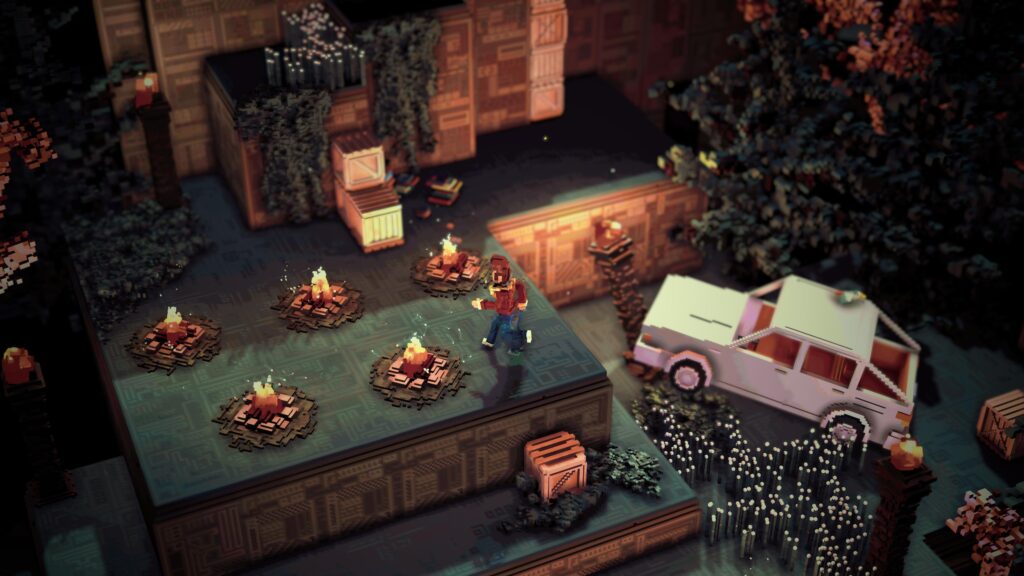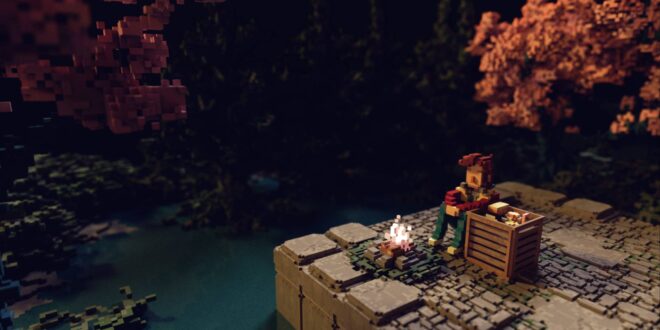
Bonfire Peaks, from developer Corey Martin, is a game that manages to be simultaneously meditative and yet immensely taxing.
The game’s narrative, such as it is, follows the adventures of a solitary man climbing a mountain, burning all of his worldly possessions as he goes. There’s no dialogue, no exposition, no context. Just put everything you own into a box and watch it burn.
It turns out that our protagonist, prior to whatever emotional breakdown prompted him to seek refuge in the flames, was something of a materialist. Any player wanting to finish all of Bonfire Peak’s puzzles (of which there are over 200) will have to do a lot of burning.
They’ll have to be quite a bit brighter than I am too – Each of the game’s hundreds of puzzles tasks you with burning a single box of your own possessions, and they’re increasingly unforgiving as the game goes on. Most puzzles can theoretically be finished in under a minute, though in reality I spent much of my time staring at Bonfire Peak’s gorgeous Voxel graphics, overburdened with possessions that I couldn’t quite figure out how to get rid of. Throwing them into the sea in frustration isn’t a valid solution, it turns out.

SACRIFICES MUST BE MADE
The game’s hands-off approach to its own narrative eases the pressure off a little. A player may get stuck trying to navigate their possessions through implausibly narrow spaces, but they certainly won’t be turned away by a dense, impenetrable story. Bonfire Peaks is more evocative of a particular emotion or an idea, rather than a specific story about a specific character.
“Bonfire Peaks started as part of the Ludum Dare game jam,” Corey Martin explains to us, “the theme was ‘Sacrifices Must Be Made.’ I had gotten used to making these character-based 3D puzzle games, and wanted to make one focused on climbing. The theme then inspired carrying something for the sake of sacrificing it, and I got a few solid puzzles out of it. From there, it took a while for it to really start taking shape.”
That theme of sacrifice goes some way to explaining the artistic intention behind Bonfire Peaks. While its lack of a traditional narrative may upset the more obsessive lore nerds among us, it’s a game that leaves itself open to interpretation – meaning any number of different things to different people.
“The short answer [behind the limited narrative] is just to limit scope,” explains Martin. “You can only make so many games in one lifetime, and should probably only spend so much time on a weird puzzle game about burning stuff.
“For me, cutting a traditional narrative is an easy choice, it’s not even a compromise. In my opinion, storytelling is not really a strength of the medium of games, or what excites me most about it. I like the ambiguity of communicating through mood and imagery, and letting every player’s interpretation be valid. I’ve heard a lot of diverse and contradictory opinions and guesses of what the game is about, and I love that.”
Following the initial game jam in November 2018, Martin worked away at Bonfire Peaks for three years – with the help of voxel artists Mari K and Zach Soares, as well as Alan Hazelden (of Draknek & Friends) who helped to effectively double the game’s level count.

PUZZLE PLANS
While the game was certainly a group effort (with too many names to list here), Bonfire Peaks’ core design philosophy speaks to Martin’s approach to puzzle game design, which he lays out for us.
“First, you should earn and maintain the player’s trust (in you as a designer, that solutions will be intuitive, that you aren’t wasting their time, etc). Second, there’s elegance in minimalism, don’t make things bigger or more complicated than they need to be.
“Third, build a system that leads to emergent puzzles. When you’ve made a rich system, it feels like you’re finding puzzles rather than creating them and that’s way easier. You should also aim for a ratio of as few elements as possible : as much depth as possible.
“Finally, verbalize the idea for each puzzle, literally put it into words. If it’s hard to talk about, it probably isn’t a very focused idea. I don’t think there’s one correct way to approach this stuff, but that’s more or less how I do it.”
Martin’s “puzzles-first” approach means that while Bonfire Peaks is certainly challenging, there’s always another puzzle to play should you ever get stuck. It stands out as an effective way to ensure players aren’t turned away by the game’s steep difficulty. That or I’m dumb, who’s to say?
“You’re not dumb, it’s supposed to be hard!” says Martin, totally unprompted. “A lot of people that play and struggle will feel ‘I’m bad at this game,’ but you’re supposed to get stuck, that’s the intended experience. The hope is that you’ll feel the puzzle solutions are charming enough to warrant the difficulty.
“I think the most significant thing we did to ease frustration is to avoid bottlenecking progress on a single puzzle. There’s always a handful of puzzles available at any point, and you only need to beat a portion of them to move forward, so I think that freedom to curate your experience at least relieves some of the aggravation.”

SAUSAGE ROLL
Bonfire Peaks pulls inspiration from all sorts of places – Some more surprising than others, as Martin explains:
“From a game design perspective, many people have rightly identified the game Stephen’s Sausage Roll as a direct influence. Also the games of Draknek & Friends had a huge impact on me, above all A Good Snowman is Hard to Build and A Monster’s Expedition. I was playtesting AME throughout Bonfire Peaks’ development and it was really inspiring in a bunch of ways.
“Outside of games, Ari Aster’s movies were on my mind a lot, especially Midsommar. I was listening to a lot of the Beach Boys, Dionne Warwick and Carole King, among others. Those are the first things that come to mind.”
In Bonfire Peaks, you may stay for the puzzles, but what first grabbed your attention is likely the game’s beautiful use of the voxel art style. It’s a style that, until recently, has been more closely associated with more cutesy affairs – rather than the quiet, sombre aesthetic of Bonfire Peaks.
“Yeah! I think that’s slowly changing, with games like Teardown and Cloudpunk. I hope there’ll be more and more ‘mature’ voxel art games in the coming years. There’s such a broad range of moods and styles within pixel art, and I feel there’s the same potential for voxel art. I’m excited to see where it goes.”
While Martin had help at various stages of the project, the “development team” is largely just Martin working alone in his apartment, alongside his regular day job. “Very indie stuff,” he explains. No matter how good the game (and Bonfire Peaks is certainly an exceptional accomplishment), that kind of work over three years can take a toll.
“Honestly, the latter half of development was kind of a slog,” Martin notes. “I think because I was lying to myself the whole time about how much further I had left to go, so it basically felt like I was “finishing the game” for half of its development. There were still some joyful moments in there, but a lot of anxiety and exhaustion as well.”
The game released in September this year to a warm critical reception, with particular praise heaped on Bonfire Peaks’ contemplative tone. Which is a pretty big achievement for a game most commonly compared to Stephen’s Sausage Roll, a game about rolling sausages (though it is, admittedly, also exceptional). But how has this matched up with Martin’s expectations for the game?
“Sales have been very modest, but it’s a super niche game, so that mostly aligned with my expectations” notes Martin. “The press coverage and player feedback definitely exceeded my expectations. After working on this for so long (by my standards, at least), it really feels great to see people enjoying and connecting with the game.”

 MCV/DEVELOP News, events, research and jobs from the games industry
MCV/DEVELOP News, events, research and jobs from the games industry




